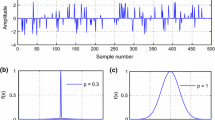Abstract
Novel space-time blind multiuser detection method for multiuser DS-CDMA and oversampled systems is presented. To achieve signal recovery, Khatri-Rao product structure of the space-time channel matrix of received signals and rank-1 projection strategy are exploited. Two blind signal detection algorithms based on Khatri-Rao product decomposition are proposed. Uniqueness of the Khatri-Rao decomposition is discussed. Simulation results show that the proposed algorithms have performance close to the non-blind Zero Forcing algorithm and still work well in the case of only few antennae in the receiving end.
Similar content being viewed by others
Abbreviations
- A T :
-
Transpose of A
- A H :
-
Conjugate transpose of A
- diag([a, b . . .]):
-
Diagonal matrix with diagonal entries a, b, . . .
- a(1 : I ):
-
A vector with a(1), . . . , a(I)
- vec(A):
-
Stacks the columns of A in a vector
- unvec(a, I, J):
-
Rearrange a IJ × 1 vector a to a I × J matrix, formulated as: unvec(a, I, J) = [a(1 : J), a(J + 1 : 2J), . . . , a((I−1)J : IJ)]
- min(a, b):
-
The minimum value of a and b
- max(a, b):
-
The maximum value of a and b
References
Wang X., Host-Madsen A. (1999) Group-blind multiuser detection for uplink CDMA. IEEE Journal on Selected Areas in Communications 17: 1971–1984
Buzzi S., Krishna-murthy V., Lops M., Poor H.V. (2003) Blind multiuser detection in multirate CDMA based on cyclic LMS adaptation. Wireless Personal Communications 27: 293–320
Yu Q., Bi G., Zhang L. R. (2006) Blind multiuser detection for long code multipath DS-CDMA systems with Bayesian MC techniques. Wireless Personal Communications 39: 265–278
Honing M., Madhow U., Verdu S. (1995) Blind adaptive multiuser detection. IEEE Transaction on Information Theory 41: 944–960
Wang X., Poor H.V. (1998) Blind multiuser detection: A subspace approach. IEEE Transactions on Information Theory 44(2): 677–690
Fantacci R., Mancini L., Marini M., Tarchi D. (2003) A neural network-based blind multiuser receiver for DS-CDMA communication systems. Wireless Personal Communications 27: 195–273
van der Veen A. J. (1998) Algebraic Methods for Deterministic Blind Beamforming. Proceedings of the IEEE 86(10): 1987–2008
Cardoso J. F. (1998) Blind signal separation: Statistical principles. Proceedings of the IEEE 86(10): 2009–2025
Choi S., Cichocki A., Park H.M., Lee S.Y. (2005) Blind source separation and independent component analysis: A review. Neural Information Processing-Letters and Reviews 6(1): 1–57
Chang A. C., Jen C. W. (2007) Complex-valued ICA utilizing signal-subspace demixing for robust DOA estimation and blind signal separation. Wireless Personal Communications 43: 1435–1450
Talwar S., Viberg M., Paulraj A. (1996) Blind separation of synchronous CO-channel digital signals using an antenna array-part I: Algorithms. IEEE Transactions on Signal Processing 44(5): 1184–1197
Manioudakis S. (2006) Blind estimation of space-time coded systems using the finite alphabet-constant modulus algorithm. IEE Proceedings-Vision Image Signal Process 153(5): 549–556
van der Veen A. J., Paulraj A. (1996) An analytical constant modulus algorithm. IEEE Transactions On Signal Processing 44(5): 1136–1155
Sansrimahachai P., Ward D. B., Constantinides A. G. (2005) Blind source separation of instantaneous MIMO systems based on the least-squares constant modulus algorithm. IEE Proceedings-Vision Image Signal Process 152(5): 616–622
Krim H., Viberg M. (1996) Two decades of array signal processing research, The parametric approach. IEEE Signal Processing Magazine 13: 67–94
Friedlander B. (1990) A sensitivity analysis of the MUSIC algorithm. IEEE Transactions on Acoustics, Speech, and Signal Processing 38: 1740–1751
Soon V., Huang Y. F. (1992) An analysis of ESPRIT under random sensor uncertainties. IEEE Transactions On Signal Processing 40: 2353–2358
Gaffar M. Y. A., Broadhurst A. D., Takawira F. (2005) Improved subspace-based channel estimation algorithm for DS/CDMA systems exploiting pulse-shaping information. IEE proceedings Communications 152(5): 533–540
Sidiropoulos N. D., Giannakis G. B., Bro R. (2000) Blind PARAFAC receivers for DS-CDMA systems. IEEE Transactions on Signal Processing 48(3): 810–823
Sidiropoulos N. D., Bro R (2000) On the uniqueness of multilinear decomposition of N-way arrays. Journal of Chemometrics 14: 229–239
Zhang X. (2004) Matrix analysis and applications. Tsinghua University Press, Beijing, China, pp 354–355
Golub G. H., van Loan C. F. (1996) Matrix computation. Johns Hopkins University Press, Baltimore, MD
Jiang T., Sidiropoulos N. D. (2004) Kruskal’s permutation lemma and the identification of CANDECOMP/PARAFAC and bilinear models with constant modulus constraints. IEEE Transactions On Signal Processing 52(9): 2625–2636
Gill P. E., Murray W., Wright M. H. (1981) Practical optimization. Academic Press, San Diego, CA
Kruskal J. B. (1977) Three-way arrays: Rank and uniqueness of trilinear decompositions, with application to arithmetic complexity and statistics. Linear Algebra Applications 18: 95–138
Author information
Authors and Affiliations
Corresponding author
Rights and permissions
About this article
Cite this article
Liu, X., Xu, Z.Z. & Lei, L. Space-Time Blind Multiuser Detection for Multiuser DS-CDMA and Oversampled Systems. Wireless Pers Commun 58, 759–783 (2011). https://doi.org/10.1007/s11277-009-9905-y
Published:
Issue Date:
DOI: https://doi.org/10.1007/s11277-009-9905-y




